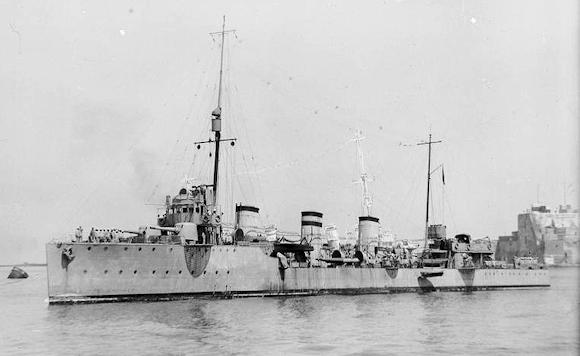The history of the Navy is also made up of ships that change their name, intended use or country of origin in the wake of economic, political or markedly warlike needs. The stories of the "explorers" of the class Aquila of the Regia Marina are exemplary in their own way.
Shortly before the outbreak of the First World War, the Romanian Navy had commissioned four units from the Italian shipyards, marked with the initials E1, E2, E3, E4, which should have taken the names of Vifor, Vijelie, Vartez, Viscol. Their work progress as of 24 May 1915, when Italy entered the war on the side of the Entente powers, was as follows: Vifor To 60% Vijelie To 50% Vartez at 20%, the Viscol it hadn't been set yet. The Royal Navy requisitioned ready units and materials and the units were classified as "explorers". Changed the names to Aquila, sparrowhawk (opening photo), Kite e Falcon, their construction was carried forward but, for a number of reasons depending on the state of war, the delivery of the units was significantly delayed.
Aquila e sparrowhawk entered service in 1917, the Kite was operational a few months before the end of the conflict, and the Falcon hostilities ceased. In 1920 sparrowhawk e Kite they were ceded to Romania which named them respectively Grow up e Marasesti; captured by the Russians during World War II, they were incorporated into the Black Sea Fleet and returned to the Romanian flag in 1945. In 1939 Aquila e Falcon instead they were secretly given to the Nationalist Spanish Navy and named after it Melilla e Ceuta.
Aquila (Motto: Alarum verbera nosce) Entering service at the beginning of 1917, the explorer was stationed in Brindisi, where she participated in various naval actions in the lower Adriatic.
On November 28 theAquila e sparrowhawk, with destroyers Spirited, Ardente, Ardito, Abba, Audace, Orsini, Acerbi, Sirtori e Stocco, departed from Venice and, together with some reconnaissance seaplanes, chased an Austrian formation made up of destroyers Dikla, Streiter ed Huszar and by four torpedo boats which had bombarded the railway near the mouth of the Metauro. The Italian ships had to give up the pursuit when they arrived near Cape Promontore too close to Pola.
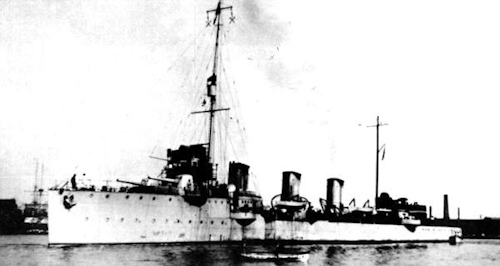
On 10 May 1918 the ship was sent to Porto Levante together with the destroyers Acerbi, Sirtori, Stocco, Ardente ed Ardito to provide any support to the incursion of MAS which later became known as the "buccari hoax".
During the conflict the Aquila carried out a total of 42 war missions for a total of 433 engine hours, while it remained ready to move for 1.032 hours.
On the morning of 6 June 1928 theAquila sailed from Pula with other units for an exercise that would also involve the light cruiser Toast. The exercise involved a simulated attack on the formation by submarines F14 e F15. Shortly after 8,40 the destroyer To the sender rammed theF14 causing her to sink 7 miles west of San Giovanni in Pelago (Pola). L'Aquila it was among the first units to rush to the spot, and the sliding of the anchor chain allowed the identification of the wreck of the submarine in which, largely unflooded, 23 of the 27 crewmen were trapped alive. During the recovery operations the presence of the anchor of theAquila a problem was detected, causing the submarine to heel. The cable was hooked to the pontoon GA145 of 30 tons sent from Pola, and theF14 could be freed from the anchor chain and brought back to the surface. However, when the hatches were opened, it was ascertained what hours of silence from the submarine had now made almost certain: the entire crew of the submarine was dead.
Surrendered on October 11, 1937 to the Spanish Nationalist Navy who named it Melilla, however, was not removed from the military fleet for political reasons. During the first period of service under the Spanish flag theAquila was fitted with a fourth dummy smokestack, so that it could be exchanged for the only non-Italian destroyer in Franco's Navy. Velasco. Being an old unit, it was mainly employed in surveillance and escort duties, but in August 1938 it participated with the twin Falcon become Ceuta and to the cruiser Canary Islands, to action which forced the Republican destroyer Jose Luis Diaz to repair to Gibraltar.
Disbarred in 1950, the Melilla was sent for demolition.
sparrowhawk (Motto: Cursu praedam inausum audet) which means: "Through untried ways he pounces on his prey". It was given to the unit by Gabriele D'annunzio, who to pay special homage to the commander wrote it on a message and dropped it from the plane as it flew over the ship.
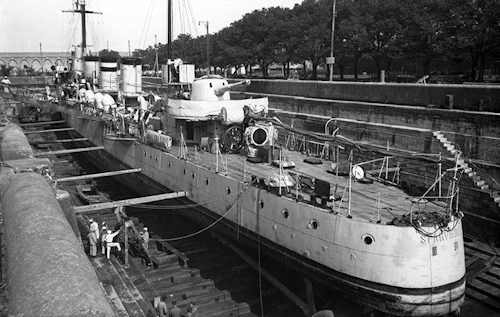
On September 29, 1917 the ship under the command of the cf Ferdinando di Savoia prince of Udine, went out to sea with the destroyers Abba, Acerbi, Orsini, Stocco, Ardente, Ardito e Boldness in support of an aircraft squadron in the bombing of Pula.
After the retreat of Caporetto sparrowhawk e Aquila were stationed in Venice, where they remained until 15 March 1918. In this period they actively participated in the defense of the lagoon city, and in missions in support of MAS towards enemy coasts.
In May 1918 it sparrowhawk he returned to Brindisi and until the end of the conflict carried out warfare in the lower Adriatic. After the war it sparrowhawk he moved to Naples for urgent work, then with his twin Kite in October 1919 he reached Constantinople employed by the Levant Squadron, operating for about a year in the waters of the Black Sea, touching Russian and Romanian ports. It was in this period that contacts began between the Italian and Romanian governments for the passage of the two ships to the Romanian Navy.
On June 1, 1920 it sparrowhawk hoisted the Romanian flag and assumed the name of Grow up. Grow up she also participated in the Second World War, during which she mainly carried out convoy escort missions on the routes between the Bosphorus and the Crimea. During one of these missions the unit sank the Soviet submarine M 31. On August 29, 1944, with the occupation of Romania by Soviet troops, the Grow up was captured in Constance and redesignated by the Soviets Lyoghyj and assigned to the Black Sea Fleet.
After the war, the Lyoghyj it was returned to the Navy of Romania which had meanwhile become a Socialist Republic, receiving the denomination of D 12.
Disbarred in 1963, the D 12 it was scrapped the following year.
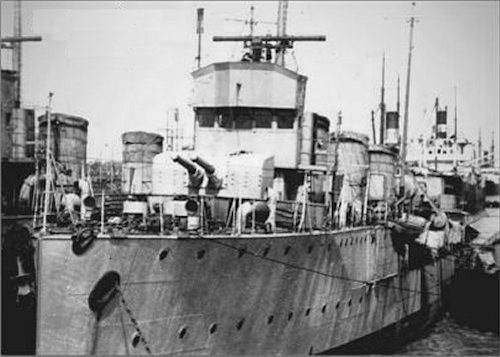 Kite (Motto: Milvus praedam rapiet) The career of this unit in the Regia Marina was particularly short.
Kite (Motto: Milvus praedam rapiet) The career of this unit in the Regia Marina was particularly short.
Delivered on 15 May 1918, she was assigned to the 3rd Group of Explorers based in Brindisi. From 20 June to the day of the armistice she carried out war activities in the Otranto canal together with the twins Aquila e sparrowhawk.
At the end of the conflict, for about a year he worked with the sparrowhawk in the waters of the Black Sea. After a year's stay in Constantinople on 18 June 1920 he moved to Constance in Romania, where on XNUMX July he lowered the Italian flag and raised the Romanian one which called him Marasesti.
Il Marasesti participated in the Second World War, during which with the twin Grow up, mainly performed convoy escort missions. In 1944 the unit was modified with the addition of 4 37 mm and 2 20 mm machine guns.
Captured on August 29, 1944 by the Soviets and incorporated into the Black Sea Fleet, it took the name of Lovkyj. After the war the unit returned to the Romanian Navy which renamed it D 11.
Written off and scrapped in 1963.
Falcon (Motto: Lead on prey) The armament of the Nibbio was initially the same as that of the Aquila, while for the Falco (the last unit of the class) it included two 152/50 and 4 76/40 cannons. The negative experience, however, which the large guns mounted on the first three units had given, and the availability starting from the first months of 1918 of the new 120/45 mm guns, meant that upon entry, the last explorer entered service was armed as follows:
4 120/45 mm guns on two twin mounts, one forward on the castle, and one aft on the deckhouse.
1 120/45 mm cannon on a single carriage, between the two aft funnels.
2 76/40 mm AA guns on the two sides of the ship towards the center astern
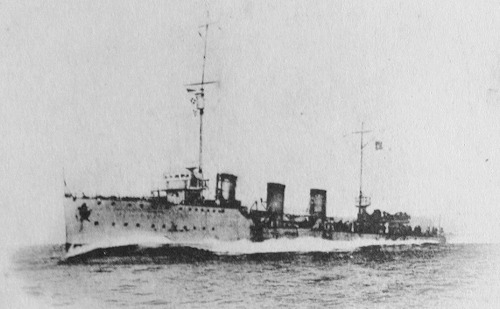
Delivered to the Royal Navy on 20 January 1920. Between 4 and 5 March 1921 the Falcon transported King Vittorio Emanuele III from Civitavecchia to Sanremo, who had gone to the Ligurian city for the funeral of the King of Montenegro, Nicholas I, who died in Antibes on XNUMX March.
On October 1937, XNUMX, it was secretly handed over to the Nationalist Spanish Navy, which named it Ceuta. During the first period of service under the Spanish flag, the Falco-Ceuta was equipped as theAquila-Melilla of a fictitious fourth smokestack.
Being an old unit, it was mainly employed in surveillance and escort duties, but in August 1938 it participated with the twin Melilla and to the cruiser Canary Islands to the action that forced the Republican destroyer Jose Luis Diaz to take refuge in Gibraltar. During the action the Ceuta cannoned the Diaz causing numerous deaths and injuries on board.
Another action that saw the Ceuta it was the capture of the French merchantman Prado, employed on behalf of the Republicans.
After the end of the war at the Ceuta and Melilla were assigned to training duties.
Il Ceuta it was struck off and scrapped in 1948.
REFERENCES
1) Historical Office of the Navy - Italian Explorers, Frigates, Corvettes and Notices - Rome 1968
2) Historical Office of the Navy - Historical Almanac of Italian Military Ships 1861-1995 - Rome 1996
3) F. Favre - The Navy in the Great War. Naval, air, underwater and land operations in the Adriatic - Editore Gaspari 2008
4) P. Ramoino - The Italian explorers 1919-1938 - Military history n. September 204, 2010.
5) R. Battista La Racine - In the Adriatic after the victory - Military History No. 210 March 2011
Photo: IWM / Regia Marina / web

